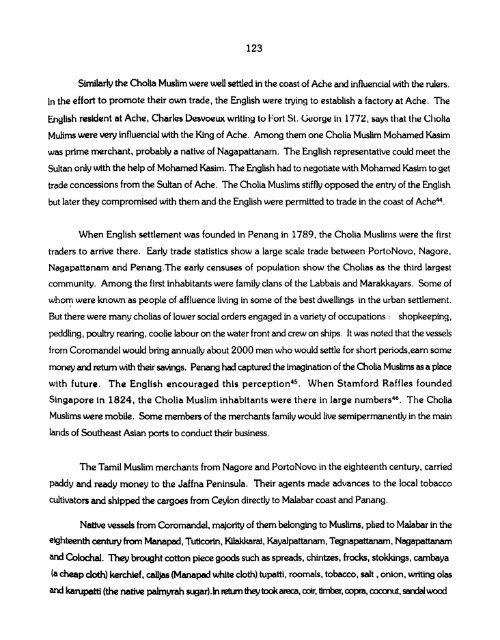maritime activities economy and social customs of the muslims of ...
maritime activities economy and social customs of the muslims of ...
maritime activities economy and social customs of the muslims of ...
You also want an ePaper? Increase the reach of your titles
YUMPU automatically turns print PDFs into web optimized ePapers that Google loves.
Similarly <strong>the</strong> Cholia Muslim were well settled in <strong>the</strong> coast <strong>of</strong> Ache <strong>and</strong> influencid with <strong>the</strong> rulers.<br />
In <strong>the</strong> effort to promote <strong>the</strong>ir own trade, <strong>the</strong> English were trying to establish a factory at Ache. The<br />
English resident at Ache. Charles Desvoeux writing to Fort St. Gorye In 1772, says tliai tlie Cliolla<br />
Mulims were very influencid with <strong>the</strong> King <strong>of</strong> Ache. Among <strong>the</strong>m one Cholia Muslim Mohamed Kasim<br />
was prlme merchant, probably a native <strong>of</strong> Nagapattanam. The English representative could meet <strong>the</strong><br />
Sultan only with <strong>the</strong> help <strong>of</strong> Mohamed Kasim. The English had to negotiate with Mohamed Kasim to get<br />
trade concessions from <strong>the</strong> Sultan <strong>of</strong> Ache. The Cholia Muslims stiffly opposed <strong>the</strong> enty <strong>of</strong> <strong>the</strong> English<br />
but later <strong>the</strong>y compromised with <strong>the</strong>m <strong>and</strong> <strong>the</strong> English were permitted to trade in <strong>the</strong> coast <strong>of</strong> Ache"<br />
When English settlement was founded in Penang in 1789, <strong>the</strong> Cholia Muslirns were <strong>the</strong> first<br />
traders to arrive <strong>the</strong>re. Early trade statistics show a large scale trade between PortoNovo. Nagore.<br />
Nagapattanam <strong>and</strong> Penang.The early censuses <strong>of</strong> population show <strong>the</strong> Cholias as <strong>the</strong> third largest<br />
community. Among <strong>the</strong> first inhabitants were family clans <strong>of</strong> <strong>the</strong> Labbais <strong>and</strong> Marakkayars. Some <strong>of</strong><br />
whom were known as people <strong>of</strong> affluence IiLing in some <strong>of</strong> <strong>the</strong> best dwellings in <strong>the</strong> urban settlement<br />
But <strong>the</strong>re were many cholias <strong>of</strong> lower <strong>social</strong> orders engaged in a variety <strong>of</strong> occupations : shopkeeping.<br />
peddling, poulhy rearing, coolie labour on <strong>the</strong> water front <strong>and</strong> crew on ships. It was noted that <strong>the</strong> vessels<br />
from Corom<strong>and</strong>el would bring annually about 2000 men who would settle for short periods.earn some<br />
money <strong>and</strong> return with <strong>the</strong>ir saws. Pe~ng had captured <strong>the</strong> imagination <strong>of</strong> <strong>the</strong> Cholia Muslims as a place<br />
with future. The English encouraged this perceptionq5. When Stamford Raffles founded<br />
Singapore in 1824, <strong>the</strong> Cholia Musllm inhabitants were <strong>the</strong>re in large number^'^. The Cholia<br />
Muslims were mobile. Some members <strong>of</strong> <strong>the</strong> merchants family would live semipermanently in <strong>the</strong> main<br />
l<strong>and</strong>s <strong>of</strong> Sou<strong>the</strong>ast Asian ports to conduct <strong>the</strong>ir business.<br />
The Tamil Muslirn merchants from Nagore <strong>and</strong> PortoNovo in <strong>the</strong> eighteenth century, carried<br />
paddy <strong>and</strong> ready money to <strong>the</strong> Jaffna Peninsula. Their agents made advances to <strong>the</strong> local tobacco<br />
cultivators ad shipped <strong>the</strong> cargoes from Ceylon directly to Malabar cost <strong>and</strong> Panany.<br />
Nadve -1s from Corom<strong>and</strong>el, rnajorlty <strong>of</strong> <strong>the</strong>m belonging to Muslims, plied to Malabar in <strong>the</strong><br />
eighteenth century from Manapad, Tutlwtin, Khkkaral, Kayalpattanam, Tegnapttanam. Nsgapttanarn<br />
<strong>and</strong> Colochal. They brought cotton piece goods such as spreads, chintzes, frocks, stokkings, carnbaya<br />
(a cheap cloth) kerchief, call)as (Manapad whlte cloth) tupatti, roornals, tobacco, salt , onion, writing olas<br />
karupatti (<strong>the</strong> native palmyrah sugar).ln miun thq, todcareca, coir, timber, oops, counut, dwmd

















